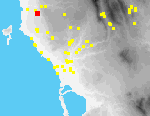 K02 Gargaliani Ayia Sotira
K02 Gargaliani Ayia Sotira
The site occupies the summit of a conical hill (ca. 125 masl; 2.7 km. NW of the outskirts of Gargaliani)[088.11], which affords unobstructed views of the surrounding countryside, including the area of Ordines and the coastal plain farther west. The hill is almost entirely covered with dense maquis except for a clearing on its flat summit, in the middle of which stands the church of Ayia Sotira.[088.16] In the clearing are several older carob and olive trees; rows of young olives were planted to the N, E, and S of this church between the summers of 1994 and 1995.
We were in 1994 able to make systematic collections only in the few parts of the hill that were free of vegetation. Although artifact densities appear to be highest on the summit in the vicinity of the church and it is there that most chronologically diagnostic artifacts were found, it is clear that archaeological remains cover a much larger area. A dirt road to the church climbs the SE slope of the hill; there are artifacts in the scarps of the road bed. N of the church, an old bulldozer track leads N, then E, from the summit, descending the NE slope of the hill. Although the floor of this track is covered with matted grass, in its scarps are small quantities of pottery; MH coarse ware was found as far as 60 m. from the clearing on the summit.
Between the summers of 1994 and 1995, the planting of olives around the church,[107.12] especially on its south side, brought many artifacts to the surface. Inspection of these artifacts in situ confirmed the data collected by our teams the previous year. MH, early LH, and late LH pottery was represented. In addition we noted the presence of two ground stone handstones and a possibly human tooth.
The site of Ayia Sotira was first described by McDonald and Hope Simpson who only reported LH pottery and estimated the size of the site at ca. 1.8 ha. Our investigations suggest that, while the maximum dimensions of the site are this great, the actual inhabited area may have been half the estimate of UMME. It is also clear that a wider range of periods is represented.
Of all of the identified prehistoric pottery, the Midde Helladic period is especially well-represented by many body sherds of thick-walled storage containers. [Neol.?--YGL to check] Also noted were a fragment of a goblet foot (LH I) and two kylix stems (LH IIIA-B), as well as body sherds of Middle Helladic and LH IIIA-B vessels.
No Historic sherds were identified that pre-dated the Byzantine period, and most of the material consists of body sherds. Several cookpot fragments, including one rim and one handle were too abraded to provide a clear date. Most of the roof tiles collected are Turkish-Modern.